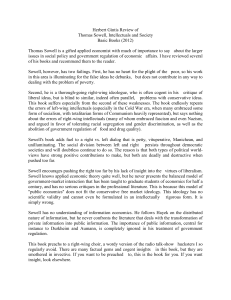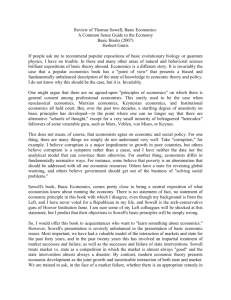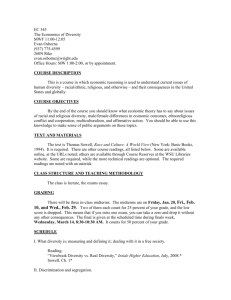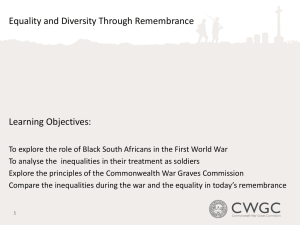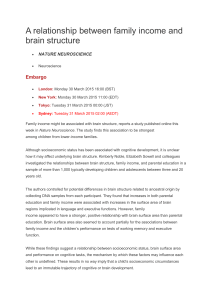Notions of Social Justice and the Inherent Problems of its Pursuit
advertisement
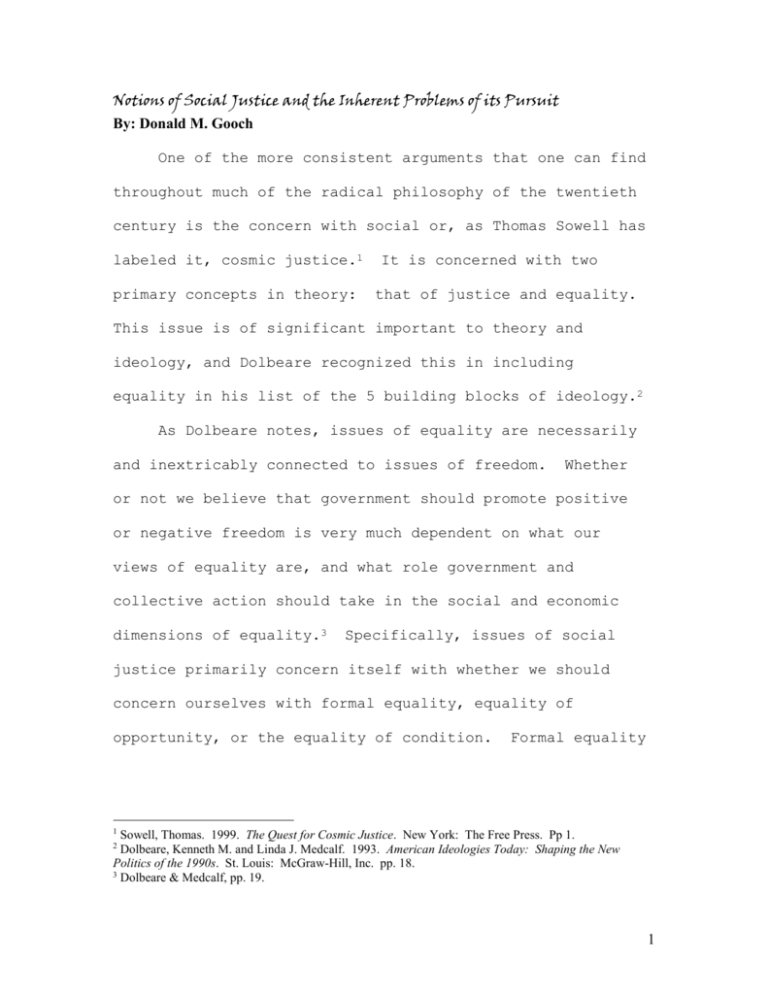
Notions of Social Justice and the Inherent Problems of its Pursuit By: Donald M. Gooch One of the more consistent arguments that one can find throughout much of the radical philosophy of the twentieth century is the concern with social or, as Thomas Sowell has labeled it, cosmic justice.1 primary concepts in theory: It is concerned with two that of justice and equality. This issue is of significant important to theory and ideology, and Dolbeare recognized this in including equality in his list of the 5 building blocks of ideology.2 As Dolbeare notes, issues of equality are necessarily and inextricably connected to issues of freedom. Whether or not we believe that government should promote positive or negative freedom is very much dependent on what our views of equality are, and what role government and collective action should take in the social and economic dimensions of equality.3 Specifically, issues of social justice primarily concern itself with whether we should concern ourselves with formal equality, equality of opportunity, or the equality of condition. Formal equality 1 Sowell, Thomas. 1999. The Quest for Cosmic Justice. New York: The Free Press. Pp 1. Dolbeare, Kenneth M. and Linda J. Medcalf. 1993. American Ideologies Today: Shaping the New Politics of the 1990s. St. Louis: McGraw-Hill, Inc. pp. 18. 3 Dolbeare & Medcalf, pp. 19. 2 1 limits equality to the “political-legal”4 dimension under the premise that interference in the socio-economic dimension is “fraught with danger” as Friedman has put it.5 However, the broader concepts of equality of opportunity (as defined by Dolbeare), where governmental attempts to ‘level the playing field’ through programs such as affirmative action are justified based on the belief that individuals should have their ‘starting’ points leveled.6 This concept was probably most famously demonstrated in President Lyndon B. Johnson’s speech discussing the plight of the Black community. You do not take a man who, for years, has been hobbled by chains, liberate him, and bring him to the starting line of a race, saying, “You are free to compete with all others,” and still justly believe you have been completely fair. 7 And while this is certainly a solid step in the direction of social justice, the theoretical justification for the equality of condition is even a step further. This concept of social justice, dealing specifically with the inequalities of this imperfect word, can be found in such radical documents as Marx’s Kapital and other redistributive efforts. The rationale for the redistributive class warfare arguments of the socialist 4 Dolbeare & Medcalf, pp. 20. Friedman, Milton. 1962. Capitalism and Freedom. Chicago: The University of Chicago Press. Pp. 2. 6 Dolbeare & Medcalf pp. 21. 7 Sowell, pp. 12. 55 2 finds its basis in their conception of equality. Debs makes much the same argument of Marx in articulating the socialist position. By virtue of his private ownership of the social tool-made and used by the cooperative labor of the working class-the employer has the economic power to appropriate to himself, as a capitalist, what is produced by the social labor of the working class. This accounts for the fact that the capitalist becomes fabulously rich, lives in a palace where there is music and singing and dancing, and where there is the luxury of all climes, while the workingmen who do the work and produce the wealth and endure the privations and make the sacrifices of health and limb and life, remain in a wretched state of poverty and dependence.8 Articulated in Professor John Rawls’ treatise, A Theory of Justice, he argues that undeserved (as defined) inequalities call for “redress,” in order to produce a “genuine equality of opportunity” (which is probably somewhere in between the equality of condition a d equality of opportunity as defined by Dolbeare).9 Mere establishment of fair and impartial rules by which we are to live by is insufficient in Rawls’ view. This ‘formal’ equality does not produce the results that Rawls is interested in. As Rawls puts it, “the rights secured by justice” are not 8 Dolbeare, Kenneth M. 1981. American Political Thought. New Jersey: Chatham House Publishers, Inc. pp. 424. 9 Rawls, John. 1971. A Theory of Justice. Cambridge: Harvard University Press. Pp. 100. 3 subject to “the calculus of social interests.”10 Equality of opportunity according to Rawls means providing everyone with equal prospects of success from equal individual effort. This kind of Cosmic justice, as Sowell defines it and as Rawls articulates (though doesn’t assign the term to it), is about putting particular segments of society who have been disadvantaged in some way in the position that they conceivably would have been but for some undeserved misfortune. balanced. Pre-existing inequalities are to be counterFurthermore, justice is to sit at the top of the categorical principles that society places at its center. Other principles and values are to be considered subordinate to those most highly valued. This is an order which requires us to satisfy the first principle in the ordering before we can move on to the second, the second before we consider the third, and so on. A principle does not come into play until those previous to it are either fully met or do not apply. A serial ordering avoids, then, having to balance principles at all; those earlier in the sequence have an absolute weight, so to speak, with respect to later one, and hold without exception.11 Thus the ‘principles of justice’ are to be ranked in “lexical order” and therefore liberty can be restricted only for the sake of liberty. This principle of “fair equality of opportunity that, as mentioned above, “equal 10 11 Rawls, pp 4. Rawls, pp. 43. 4 life prospects in all sectors of society for those similarly endowed and motivated,” reigns supreme to all other considerations.12 The concept of the ‘trade-off’ is foreign to such a framework. As seen in the comment by Debs, often implicit and sometimes explicit in this debate over the need to rectify social inequities is the notion that segments of society (in Debs case, the working class), through no fault of their own, lack things (capital) that others receive as windfall gains (capitalist), through no virtue of their own. In fact, according to Debs, those most worthy of the windfall gains are those who suffer and toil. This is best articulated by Marx (upon whom Debs relied for theoretical justification) in the labor theory of value. He argued that labor was both the source of the workers’ livelihood and of their exploitation. Since capitalist society denied a worker a fair return for his or her labor, a substantial proportion of the worker’s productivity was returned to the capitalist as profit, or in Marx’s terminology, as ‘surplus value’ stolen from the worker.13 The problem with social or Cosmic justice as defined is not its identification or even dissatisfaction with 12 Rawls, pp. 250. Lerner, Warren. 1994. A History of Socialism and Communism in Modern Times: Theorists, Activists, and Humanists. New Jersey: Prentice Hall. Pp. 33. 13 5 inequalities. Even free market theorists such as Friedrich A. Hayek and Milton Friedman have expressed a similar disconcertment with the ‘unfair’ nature of the world. Hayek said, “the manner in which the benefits and burdens are apportioned by the market mechanism would in many instances have to be regarded as very unjust if were the result of a deliberate allocation to particular people.” However, he argued that the primary reason this was not so was because “the particulars of a spontaneous order cannot be just or unjust.”14 Friedman stated, in Free to Choose, that “everywhere in the world there are gross inequities of income and wealth. They offend most of us. Few can fail to be moved by the contrast between the luxury enjoyed by some and the grinding poverty suffered by others.”15 the true point at issue is how to address them. But Socialists like Debs and, to a lesser extent, liberals such as Galbraith and Rawls believe that the state can accomplish this. However, the problem is not in theoretically conceiving that the ‘state’ can or should redress these inequalities, but in fact it is whether doing so is even 14 Hayek, Friedrich A. 1978. Laws, Legislation and Liberty, Vol. 2. The Mirage of Social Justice. Chicago: University of Chicago Press. Pp. 33, 64. 15 Friedman, Milton and Rose Friedman. 1980. Free to Choose: A Personal Statement. New York: Harcourt Brace & Company. Pp. 146. 6 plausible. As Sowell puts it, “ the knowledge required to sort this out intellectually, much less rectify it politically, is staggering and superhuman.”16 problem is quite clear: The first society (despite the contention of socialists) cannot be divided into neat categories of the advantaged and the disadvantaged. In fact, every individual in society may have both windfall advantages and windfall disadvantages, and the calculation of these pluses and minuses for each individual, assuming we can agree on assigning a value to each, will vary significantly from person to person. Furthermore, these advantages and disadvantages do not stay constant. and with new circumstances. They change over time Donald Trump can be a multi- billionaire one moment, bankrupt the next, and a multibillionaire again the next moment. money. It doesn’t stop with A very attractive woman may find that she gains advantage in job seeking, but as she ages she may loose that advantage…and in fact her looks may become a significant disadvantage and bar to her employment prospects. The rags to riches stories we often read about in the Style section of a newspaper are not mere exceptions to be noted, but rather are extreme examples of a 16 Sowell, pp. 14. 7 particular problem in finding a practical mechanism to accomplish the ‘redress’ that Rawls and his fellow compatriots of Cosmic justice desire. Or as Sowell puts it, “the history of every people is a product of innumerable cross-currents, whose timing and confluence can neither be predicted beforehand nor always untangled afterward.”17 However, formal equality, does not face these same pitfalls. Applying the same rules to everyone requires no prior knowledge of anyone’s physical characteristics, personal history, culture, demographics, historical and family influences, or what happened to his ancestor in the 19th century. The possibility, in fact, probability for error that attempts to use the state resources in determining (or presuming) these various aspects of individual lives and the nature of their complex interactions cannot be ignored. Ah, but is it really necessary for the state, through its governmental actors, to measure all the advantages and disadvantages and take them all into account? Perhaps using well-defined groups and demographics we can, to a certain extent, redress significant and systematic 17 Sowell, pp. 15. 8 disadvantages in certain areas. For example, income distribution ‘groups’ such as the poor and the rich may be statistically determined. Perhaps the socialists, in identifying the capitalists and working classes, have set forth a framework where redressing inequalities of ‘opportunity’ (as Rawls defines it) may be possible. Clearly this is an absolute necessity. If the government cannot measure comparative inequality, then any actions it takes on behalf of the supposed ‘disadvantaged’ would ultimately be arbitrary. However, let’s for the moment assume that it is possible. As Friedman has argued, there is a clear connection between economic freedom and political freedom. However, if inequality is the natural state of the market and capitalism as Debs and fellow adherents to social justice suggest, then, as Sowell argues, “economic equality…may be achievable only by political measures which require vast concentrations of power in a relatively few hands in government…”.18 In fact, Friedman goes so far as to argue that there are only “two ways of coordinating the economic activities of millions. One is central direction involving the use of coercion…the other is the voluntary co-operation of individuals-the 18 Sowell, pp. 53. 9 technique of the market place.”19 Thus we may be faced with the prospects of creating significant political inequality as the expense for redressing economic inequality. Thus, the cure may be worse than the disease. Returning to the problem of defining economic disadvantages, as we have seen with Debs, conceptually they distinguish between capitalists and workers…and nary the twain shall meet. who is who? Yet how will the government determine Capitalists tend not to walk around with nametags stating: Bob Jones, Capitalist. One way would be using statistical disparities in terms of reported income. Though any line between the poor and the middle class is arbitrary, perhaps the categories themselves would provide a useful and consistent manner of identifying the disadvantaged and the advantaged. However, as Sowell notes, in any given year, many entrepreneurs (contrary to the argument of Galbraith, these folks do still exist) may be earning not only low incomes, but also negative incomes as their business incurs losses for that fiscal year.20 The point being that, contrary to the conception offered by socialists, we are not dealing with stable and mutually exclusive categories where the 19 20 Friedman, pp. 15. Sowell, pp. 54. 10 poor (working class) are always poor, and the rich (capitalists) are always rich. Indeed, socialists and liberals propose to do just that. Henry Wallace, in discussing the implications of the New Deal, suggested that (in reference to these kind of regulations) “their significance lies in the fact that by their manipulation it is possible to direct, stimulate, restrain, and balance those forces which have to do with proportioning the national income.”21 Yet the transience of individuals in and out of income categories makes this proposition somewhat suspect. Most Americans do not stay in the same quintile of the income distribution for as long as a decade.22 And there are other problems. Many members of high school and college graduating classes enter the labor force in the middle of the year, earning only about half of what they will normally be earning when they work the entire year. what extent is the And to “wretched state of poverty” that Debs described the condition of the working class true today? More than one-fourth of the ‘poor’ own two cars and/or truck and hundreds of thousands of them own homes costing 21 Mason, Alpheus Thomas. 1965. Free Government in the Making: Readings in American Political Thought. New York: Oxford University Press. Pp. 778. 22 Sowell, pp. 54. 11 more than $150,000.23 Two-thirds of the statistically defined ‘poor’ have air-conditioning, and more than half own a car or truck.24 And what of financial assets? Not all ‘wealth’ as conceived by socialists and liberals consist of yearly income derived from profits from a business or a job. This presents a problem in using income distribution as a categorical tool for the distribution of social justice. Thus someone with a million dollars in the bank, or who owns property worth several million, will be counted among ‘the poor’ during off years in his business or profession, when his revenues for a particular year barely exceed his costs for that particular year, or when his net income for that year may be negative. 25 And what of the other side of the distribution? Are capitalists really living off the fat of the land without a care in the world? The average cost of the automobiles for mutli-millionaires is $24,800, hardly the price for a Lexus.26 A major factor in both income and wealth is age. Those who have worked for many years tend to have advanced in their careers to higher-paying positions and to have accumulated more assets. People in their sixties have persistently had higher incomes than people in their 23 Sowell, pp. 56. Sowell, pp. 54. 25 Sowell, pp. 56. 26 Sowell, pp. 56. 24 12 twenties and much higher net works.27 For example, a full professor of political science likely has an income far exceeding that of a Masters student in political science only working part time. Thus neither the rich nor the poor match the Debs picture of the class into which people are born, nor is membership in a particular income bracket stable, let alone terminal. As a simple hypothetical example, imagine that each individual at age 20 begins his working career earning an annual income of $10,000 and remains at that level until he reaches age 30, when he receives a $10,000 raise. That raise is repeated at each decade until his 60’s, with his income going back to zero when he retires at age 70. Assuming identical savings patterns and a basic notion of their essential ‘subsistence’ needs, and that they will save 10 percent of whatever they earn above that. AGE 20 30 40 50 60 70 27 ANNUAL INCOME $10,000 $20,000 $30,000 $40,000 $50,000 0 “SUBSISTENCE” ANNUAL SAVINGS $5,000 $500 $5,000 $1,500 $5,000 $2,500 $5,000 $3,500 $5,000 $4,500 $5,000 0 LIFETIME SAVINGS 0 $5,000 $20,000 $45,000 $80,000 $125,000 Sowell, pp. 60. 13 We can see that there are great disparities between the incomes and savings of these individuals. In fact, the top 17 percent of income earners have five times the income of the bottom 17 percent. So one must question whether all that concern over class that was at the essence of Debs (and Bellamy as well) and other socialists and liberals was not really misplaced. Similar difficulties can be found in affirmative action programs and other social reforms designed to redress historical disadvantages associated with race and gender. Whether one argues the historical legacy of slavery as does the Black scholar Michael Eric Dyson when he suggests that slavery “continues to exert its brutal presence in untold sufferings of millions of everyday folk,”28 or the continues presence of racism and discrimination today in ourselves and our institutions as Toni Morrison argues when it is said that “Racism is as healthy today as it was during the Enlightenment…it <racism> has assumed a metaphorical life so completely embedded in daily discourse that it is perhaps more necessary and more on display than ever before,” the argument that this historical/present inequality/injustice D’Souza, Dinesh. 1995. The End of Racism: Principles for a Multiracial Society. New York: The Free Press. Pp. 67 28 14 should be redressed is the essence of the arguments in favor of affirmative action and racial reparations.29 Yet again we are presented with the problem of how do we measure this inequality? to redress it? end? What policies should we adopt Do these policies actually accomplish our Again we look to statistical tools in order to aggregate individuals into groups (in this case the demographic of race) in attempts to redress the wrongs done to individuals within these groups. Thus we see that affirmative action has the goal of proportional representation within societies economic and social institutions. As the Supreme Court stated in 1977: It is ordinarily to be expected that nondiscriminatory hiring practices will in time result in a work force more or less representative of the racial and ethnic composition of the population in the community from which employees are hired. 30 Thomas Sowell sets out the ‘common procedure’ for this: 1) establish that there are statistical disparities between two or more groups, 2) demonstrate that the odds that these particular disparities are a result of random chance are very small, and 3) show that, even holding constant various nondiscriminatory factors which might influence the outcomes, that still leaves a substantial residual 29 30 D’Souza, pp. 17. D’Souza, pp. 220. 15 difference between the groups, which must be presumed to be due to discrimination.31 Yet, is this a reasonable expectation? Sowell suggests that, while race does not change the fundamental principles of economics, the application of economic principles in a racially and culturally heterogeneous population introduces complications beyond those in homogeneous populations. He suggests that cultural differences between groups are reflected in their roles as workers, consumers, entrepreneurs, tenants, or other “economic transactors.”32 Thus it is certainly conceivable that cultural norms and values may cause certain groups to tend towards certain jobs and employment sectors w/o the presence of discrimination. As Sowell puts it, “that discrimination or bias can be inferred from statistical inequalities…is the reigning non sequitur of our times, both intellectually and politically.”33 In fact, he points to several statistical ‘disparities’ between gender and race that, of course, have nothing to do with discrimination. For example, American men are struck by lightning six times as often as American women. A 1985 study in the United States showed that the 31 Sowell, Thomas. 1995. The Vision of the Anointed: Self-Congratulation as a Basis for Social Policy. New York: Basic Books. Pp. 32 Sowell, Thomas. 1994. Race and Culture: A World View. New York: Basic Books. Pp. 1. 33 Sowell, pp. 62. 16 proportion of Asian American students who scored over 700 on the mathematics portion of the SAT was more than double the proportion among whites.34 Furthermore, there is the argument that these kinds of social programs designed to address disparities due to discrimination actually become a self-fulfilling prophecy. That, by increasing the ‘cost’ of hiring a minority or woman (by making it more difficult to fire an individual given the prospects of possible legal action), these laws actually create a disincentive to the hiring of those they are supposed to help. Or, where an employer’s failure to have a workforce ethnically representative of the local population is taken as evidence of discrimination, this can create an incentive for employers to locate their businesses w/o a concentration of minorities so as to avoid legal trouble, thus depriving minorities of job opportunities.35 While social or Cosmic justice reflects a very justifiable moralistic rejection of inequality, the practical application of such a theoretical framework leaves much to be desired. There is an alternative to social reform utilizing the coercive power of the state in 34 35 Sowell, pp. 35-36. Sowell, pp. 32. 17 attempts to redress perceived inequalities and injustices. This is the ‘rule of law’…or formal equality as both Rawls and Dolbeare refer to it. A “government of laws and not of men” where rules are known in advance, applied generally, and constrain the rulers as well as the ruled is inherent to the sort of freedom that libertarians such as Friedman and conservatives like Sowell suggest as the appropriate role of government when it comes to the issue of social justice and equality. The focus of this alternative is on an equal process, rather than equal results. Rules equally applicable to all are not the same as rules with equal impact on all. Yes, the law, in “its majestic equality, forbids the rich as well as the poor” to sleep under bridges and steal bread. However, despite France’s sarcasm, this is not something to lament. While neutral laws may have a disparate impact on different individuals and groups, this is a necessary function of the realities that are inherent to the harsh world we live in. As Burke said, “all men have equal rights; but not to equal things.”36 While socialists such as Debs believe that such disparities demand government action to ameliorate them, in 36 Sowell, pp. 152. 18 fact equality of opportunity (as Rawls defines it) is at best a highly improbably and mostly unworkable prospect. The necessarily daunting prospect of trying to measure and weigh the various advantages and disadvantages of the multitudes in a country requires the state to settle on a less than desirable proxy of categorization. While traditional justice concerns rules of interactions between individuals, cosmic justice concerns abstract categories with results adjusted by third parties utilizing the coercive power of the state. The collectivization of otherwise individual decisions and the transfer of the power to make and enforce these collective decisions to the state in order to achieve social justice place the moral responsibility for these disparities at the foot of the state. Rather than merely being responsible for neutral laws as the umpire in a baseball game does, the state is now responsible for making sure that the score ends in a tie. Further making the prospects of the application of social justice problematic is the fact that the inherent scarcity of resources, even in a socialized state, means that all the disadvantages cannot be addressed (even if they can be addressed effectively) simultaneously. This 19 requires government actors to pick and choose those groups that will receive attention, creating perverse incentives for these groups and the government. As Sowell notes, “there are now more reasons for various segments of society to fight each other politically, and perhaps physically, over benefits that were once shared peacefully and unconsciously through the ordinary operations of the marketplace.”37 Thus, while social or Cosmic justice is certainly concerned with very real disadvantages and inequalities that ‘tweak the soul’ so to speak, the practical application of this principle of equality of ‘condition’ or ‘opportunity’ (as Rawls defined it) presents daunting difficulties in the measuring of the disadvantages, the identification of those that change over time, the use of statistical tools, and the selection of what disadvantages to address given scarce resources. Social Justice is simply not a principle that leads to good government, and, in fact, pursued using the coercive power of government may in fact have deleterious effects on the very groups it is purporting to aid through the redress of Cosmic injustices. 37 Sowell, pp. 157. 20
